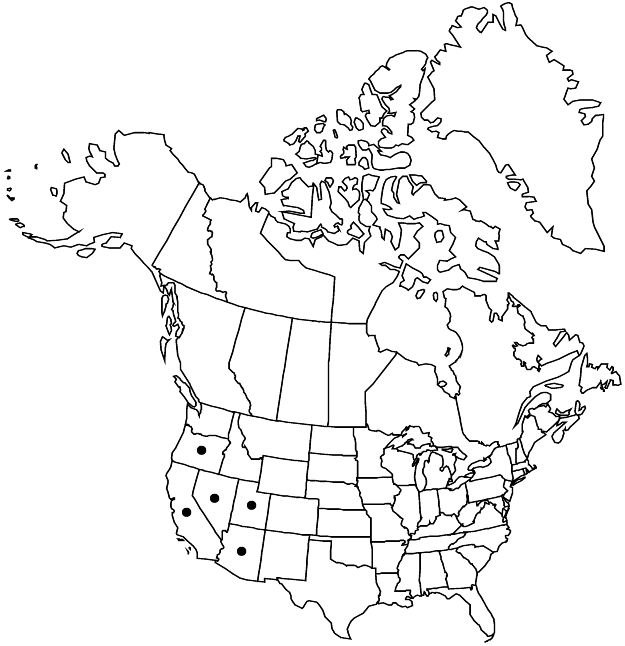Difference between revisions of "Eriogonum nutans"
Proc. Amer. Acad. Arts 8: 181. 1870.
FNA>Volume Importer |
RevisionBot (talk | contribs) m (Bot: Adding category Revised Since Print) |
||
| (2 intermediate revisions by 2 users not shown) | |||
| Line 6: | Line 6: | ||
|place=8: 181. 1870 | |place=8: 181. 1870 | ||
|year=1870 | |year=1870 | ||
| + | }} | ||
| + | |special_status={{Treatment/ID/Special_status | ||
| + | |code=E | ||
| + | |label=Endemic | ||
}} | }} | ||
|basionyms={{Treatment/ID/Basionym | |basionyms={{Treatment/ID/Basionym | ||
| Line 25: | Line 29: | ||
-->{{Treatment/Body | -->{{Treatment/Body | ||
| − | |distribution= | + | |distribution=Ariz.;Calif.;Nev.;Oreg.;Utah |
|discussion=<p>Varieties 2 (2 in the flora).</p> | |discussion=<p>Varieties 2 (2 in the flora).</p> | ||
|tables= | |tables= | ||
| Line 55: | Line 59: | ||
|basionyms=Eriogonum cernuum var. purpurascens | |basionyms=Eriogonum cernuum var. purpurascens | ||
|family=Polygonaceae | |family=Polygonaceae | ||
| − | |distribution= | + | |distribution=Ariz.;Calif.;Nev.;Oreg.;Utah |
|reference=None | |reference=None | ||
|publication title=Proc. Amer. Acad. Arts | |publication title=Proc. Amer. Acad. Arts | ||
|publication year=1870 | |publication year=1870 | ||
| − | |special status= | + | |special status=Endemic |
| − | |source xml=https:// | + | |source xml=https://bitbucket.org/aafc-mbb/fna-data-curation/src/2e0870ddd59836b60bcf96646a41e87ea5a5943a/coarse_grained_fna_xml/V5/V5_831.xml |
|subfamily=Polygonaceae subfam. Eriogonoideae | |subfamily=Polygonaceae subfam. Eriogonoideae | ||
|genus=Eriogonum | |genus=Eriogonum | ||
| Line 67: | Line 71: | ||
}}<!-- | }}<!-- | ||
| − | -->[[Category:Treatment]][[Category:Eriogonum subg. Ganysma]] | + | --> |
| + | |||
| + | [[Category:Treatment]] | ||
| + | [[Category:Eriogonum subg. Ganysma]] | ||
| + | [[Category:Revised Since Print]] | ||
Latest revision as of 17:09, 6 November 2020
Herbs, spreading to erect, annual, 0.5–3 dm, glandular or glabrous, occasionally glaucous, greenish, grayish, or reddish. Stems: caudex absent; aerial flowering stems erect, solid, not fistulose, 0.3–1.5 dm, glandular or glabrous, occasionally glaucous. Leaves basal; petiole 0.5–2.5 cm, tomentose; blade broadly reniform to round, 0.5–2.5 × 0.5–2.5 cm, densely white-tomentose abaxially, floccose to glabrate and greenish adaxially, margins plane. Inflorescences cymose, open to diffuse, 5–20 × 5–20 cm; branches glandular or glabrous, occasionally glaucous; bracts 3, scalelike, 0.5–2 × 1–2.5 mm. Peduncles recurved to cernuous, curved or sometimes straight, slender, 0.3–1 cm, glandular or glabrous. Involucres campanulate, 2–3 × 2–3.5 mm, glandular or glabrous; teeth 5, erect, 0.5–1 mm. Flowers 2–3 mm; perianth white with greenish or reddish midribs, becoming rose or red, glabrous; tepals dimorphic, those of outer whorl oblong to oval, those of inner whorl oblanceolate; stamens included, 2–3 mm; filaments pilose proximally. Achenes brown, 3-gonous, 1.7–2 mm, glabrous.
Distribution

Ariz., Calif., Nev., Oreg., Utah
Discussion
Varieties 2 (2 in the flora).
Selected References
None.
Key
| 1 | Peduncles and involucres glandular; nw Arizona, ec California, n and c Nevada, se Oregon, w and ec Utah | Eriogonum nutans var. nutans |
| 1 | Peduncles and involucres glabrous; Elko County, Nevada, apparently introduced but not persisting in Nevada County, California | Eriogonum nutans var. glabratum |